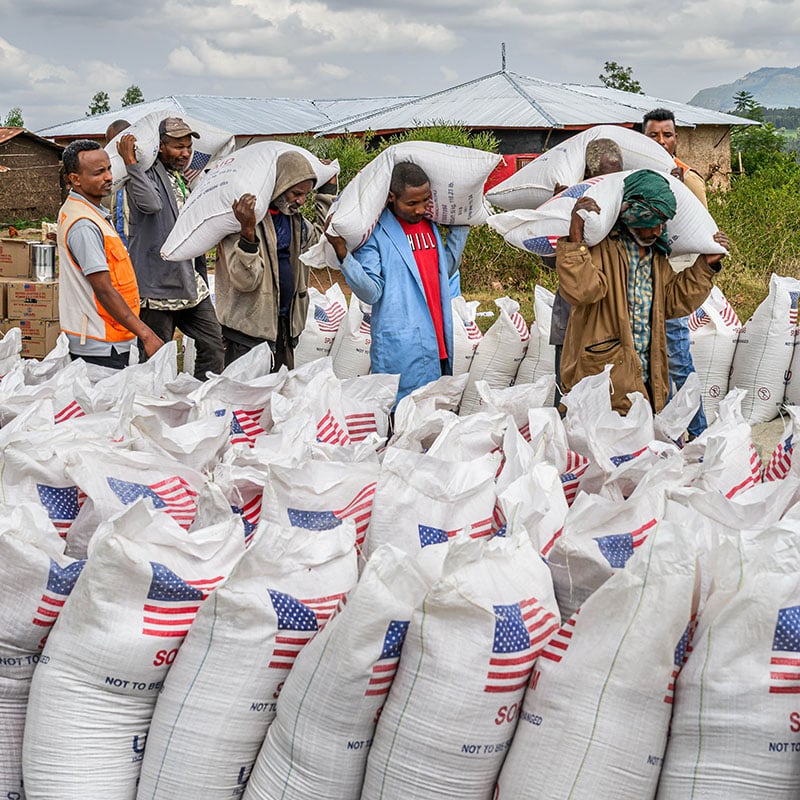World Vision warns: disruptions in US food aid impacts farmers at home and hungry children abroad
Media Contact :
October 14, 2025
Senior Public Relations Manager
[email protected]
m 404-735-0871
Media Contact :
October 14, 2025
Senior Public Relations Manager
[email protected]
m 404-735-0871

WASHINGTON D.C. (October 14, 2025) — This year, World Food Day comes as ongoing disruptions to U.S. food assistance and agricultural supply chains create an uncertain future for American farmers, humanitarians, and food insecure children around the world.
Signed into law by President Eisenhower in 1954, Food for Peace purchases surplus crops from American farmers to use in hunger relief work, reinvesting in America’s rural communities and empowering humanitarians to rapidly respond to global hunger. This year, Food for Peace and related programs have purchased a fraction of farmers’ commodities compared to previous years and released less for use by aid workers.
Uncertainty for American Farmers
The loss of sales from Food for Peace and food assistance programs is compounding the hardships on farms across the country. Purchasing over a million metric tons of crops from American farmers in previous years, U.S. food assistance has been a significant buyer of surplus crops.
“We’ve lost markets,” says Cathy Kaufman, a farmer in western Nebraska, whose produce was used in food assistance. “The loss of foreign aid is the loss of a market for farmers’ surplus.”
Local produce processors estimate that roughly 5 to 10 percent of crop sales in Kaufman’s farming community come from food assistance programs like Food for Peace. Kaufman’s and many families in town have been farming in the Great Plains for over 100 years. However, like farm communities across the nation, rising expenses and declining sales and crop prices are pushing farmers to bankruptcy. One farm in Kaufman’s community has already closed, and two more are expected to fold soon.
“What are they going to do when the silos are full and the prices are down, and farmers are going out of business because they can’t do it anymore?” says Kaufman in response to the drop in food assistance sales. “We have the food, and they have the need, and they’re not being brought together.”
But it’s not just business for many farmers—it’s a source of pride that America is using their crops to lead the fight against world hunger.
“Our beans—our beans—have gone to those programs,” Kaufman says. “It’s such a good feeling that we can raise something that can get there and alleviate that hunger. That this little Nebraska farm could feed somebody.”
Uncertainty for humanitarians and food insecure families
“There is a lot of uncertainty at this point about when food is going to start moving again for our critical lifesaving programs,” says Margaret Schuler, World Vision’s senior vice president of international programs. “The system for ordering farmers’ surplus commodities is not currently functioning and there are delays in getting food assistance for the most vulnerable populations we serve around the world.”
The dry season in many regions of the world is quickly approaching, when children and families are most at risk. Even if lifesaving food assistance were ordered today, the window of opportunity is closing to have food procured from farmers, shipped, and delivered in time for distribution. American food assistance not only responds to emergency needs but also prevents famines and stops instability and humanitarian needs from taking root.
“We know all too well the devastating impact of hunger and famine,” says Schuler. “These American-grown commodities are one of our best tools for meeting immediate needs and preventing hunger and forced migration. It is exponentially easier and cheaper to prevent a famine than to respond to one.”
When conflict or natural disaster breaks food systems, humanitarians use American-grown commodities to help fill the gap. Bags of emergency food stamped with the American flag are a welcomed sight for families living through their most difficult moments.
“Humanitarians are already working in some of the world’s most challenging environments—conflict zones, droughts, and disasters,” says Schuler. “The uncertainty around food assistance funding makes it even harder to serve those in greatest need. Now is the time to act decisively and ensure these vital programs continue to deliver hope and nourishment where it’s needed most.”
History of Food for Peace
Following World War II, the U.S. agriculture industry made rapid advancements and began to produce more crops than the American people could eat or trade. Peter O’Brien, a Kansas farmer, grew tired of seeing his crops going to waste. At a Farm Bureau meeting in 1953, O’Brien shared his idea to use surplus American produce to help feed people facing hunger around the world.
The idea was signed into law by President Eisenhower in 1954 and become known as Food for Peace, the U.S.’ signature hunger relief program named with the belief that a world without hunger was a world closer to lasting peace. With widespread support from American farmers and humanitarians, Food for Peace has fed more than 4 billion people. Through related development programs, Food for Peace equips farmers around the world with the skills and tools to feed their own families and communities for the long term.
About World Vision:
World Vision is a Christian humanitarian organization dedicated to working with children, families and their communities worldwide to reach their full potential by tackling the causes of poverty and injustice. Motivated by our faith in Jesus Christ, we serve alongside the poor and oppressed as a demonstration of God’s unconditional love for all people. World Vision serves all people, regardless of religion, race, ethnicity or gender. For more information, visit worldvision.org or follow on X @WorldVisionUSA.